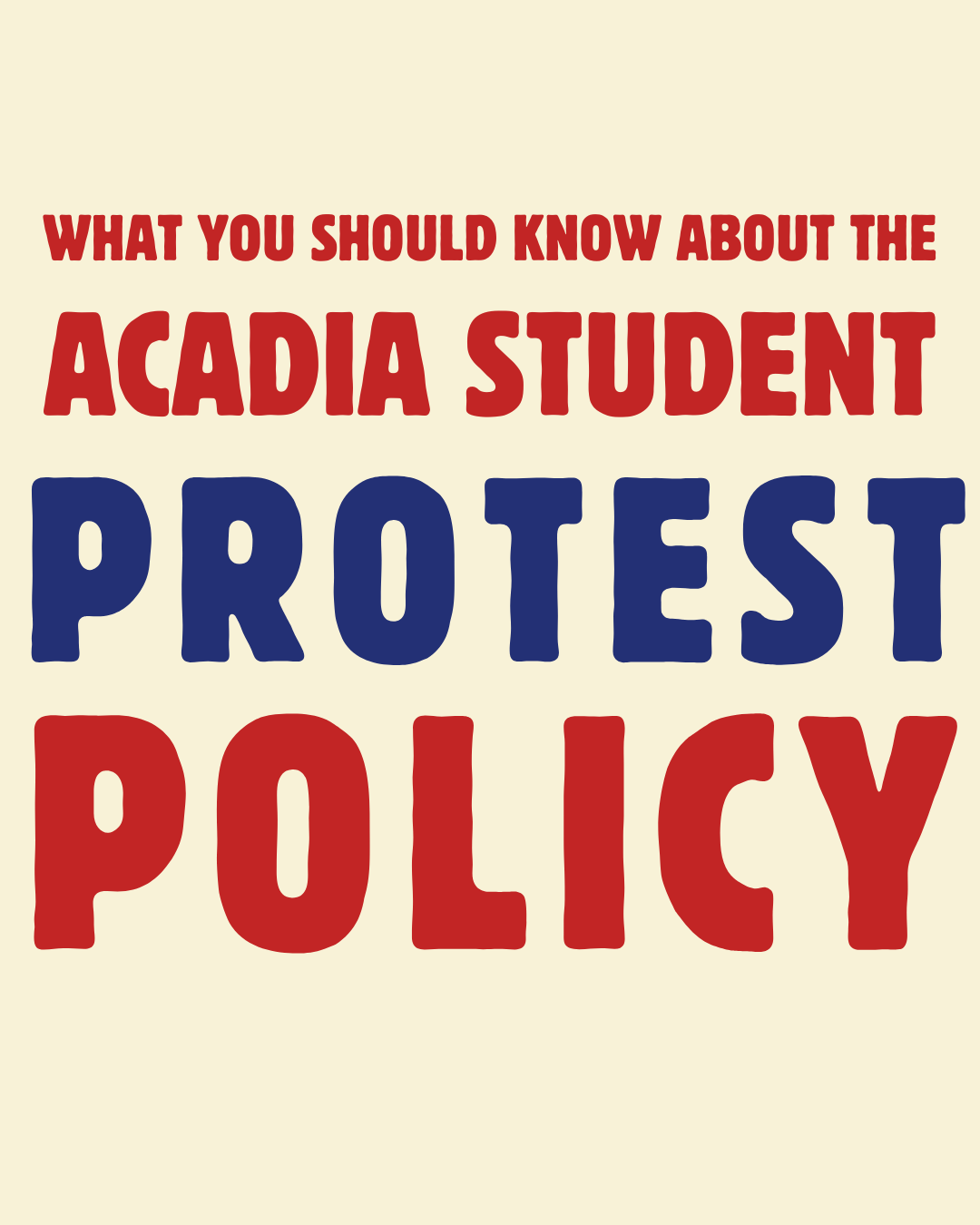This past Tuesday, Acadia students and members of the ASU gathered at the Axe to join a forum and Q&A session related to Acadia’s newly instated protest policy.
The gathering comes amid calls for reform and deeper consultation by concerned students. Since the policy was quietly passed right before the start of the 2024/25 year, student organizers and students from marginalized groups – including 2SLGBTQIA+, BIPOC, and international students – have expressed concern over the policy’s strict yet vague wording.
What is the Acadia Student Protest Policy?
Officially titled as the policy on Campus Protests and Demonstrations, the Protest Policy outlines rules and regulations for on-campus protests organized by students. Sources tell the Athenaeum that the policy was created after a wave of pro-Palestine student encampments erupted on campuses across North America. The university’s official position on the intent of the policy is to protect students and stop encampments, according to a member from the ASU.
The official policy statement asserts that it intends to support “the right to peaceful and lawful protest and demonstration as a vital part of freedom of expression and the democratic process.”
But the policy covers more than just encampments. As it stands, the vague wording of many subsections of the policy has raised concern that the university would have the power to disperse and discipline participants in any form of protest – including peaceful, non-violent ones.
What Sections?
Subsection 3.2 and 3.3 were routinely mentioned and critiqued during the discussion. 3.2 – No Impediment to Regular University Business, states that “demonstrations must not substantially and materially impede or disrupt the regular business of the university.” Some examples it lists include disrupting classes, deplatforming speakers, disrupting ‘academic activities’ (which is never defined), or interfering with scheduled events.
This means that many forms of non-violent protest – such as student sit-ins, student strikes, or student walk-outs – are also banned under this policy. Students note that banning ‘disruptive’ protesting, even if non-violent, seems counterintuitive. One student, exasperated, asked “What do they think a protest is?”.
Another example includes ‘deplatforming,’ was strongly questioned by students. The policy defines this as any activity – vocal or visual (such as holding up signs) – that “substantially interfere with a speaker’s ability to be heard.” Acadia professor Dr. Shelley Price, who attended the Q&A session, wondered how this policy would affect Indigenous student protesters. “Can we drum?”
It was also questioned how holding up signs interferes with someone’s ability to speak or be heard. Critics argued that it should be taken out of the policy’s definition of deplatforming completely.
Things are further confused with the following subsection, 3.3 which places time restrictions on when protests are allowed to occur. The section states that protests and demonstrations are only allowed to happen during regular university hours. Austin, one of the students in attendance, argued that this contradicted the previous subsection. “As it currently stands, you’re not allowed to impede regular university business. But at the same time, you’re only allowed to protest during regular university business.”
Section 4 outlines the responsibilities of people participating in demonstrations. There was a fair amount of criticism over the use of the term ‘neutrally’ in subsection 4.2, University Administration, which states “The university administration is responsible for ensuring that this policy is applied neutrally and communicated clearly to all members of the university community.” Students question if neutrality in the context of protest is possible, especially if the vagueness of the policy leaves it up for interpretation and at the whims of university administration.
Subsection 4.3, Safety and Security, “Participants in a protest or demonstration may not impede Safety and Security personnel in any way” was highlighted by students for its vagueness. “What do they mean by that,” said one student, “are we not allowed to disagree with them?”
Section 5, Compliance, leads to student concerns about Safety and Security’s training. Some are questioning if Safety and Security are actually trained on how to handle a demonstration. If that training does exist, what does it look like?
Who is Most Affected by this Policy?
Dr. Jones and students criticize the emphasis of ‘neutrality’ in section 4 of the policy. They argue that it makes it so that marginalized students and student groups are the most likely to be impacted by this policy. “Neutrality always defers to the status quo,” said Dr. Jones.
An international student present at the forum argued that the policy has negative implications for other international students. He cites that the international students are already in a precarious situation, as standing up for themselves carries more risk if being expelled also means being deported. “International students don’t fight for their rights because they’re afraid.”
Students also mentioned that the policy fails to discuss students who are also employed by the school. If punishment for employees is different from punishment for students, then how are those students impacted by this policy?
Why Vagueness Matters.
Writer, activist, and prison abolitionist Dr. El Jones was in attendance at the Q&A session to talk to students about protesting and navigating policy. The vagueness of the language in the document was the chiefest concern for her.
“They like to say things vaguely and not have to clarify so that they have a lot of power,” she stated. “The policy they’ve given you is incomplete and unclear.”
Dr. Shelley Price had similar comments about the language of the policy. She criticised it as a “colonial policy with threatening language.” She cited the compliance section specifically, as it asserts the university’s right to “restore order” without any clarification of what a compliance procedure would look like in practice.
Both Dr. Jones and Dr. Price note that keeping the language of the policy vague ensures that the university retains the ability to interpret the policy however they like. It provides students who may face disciplinary action with no ability to argue or defend themselves.
One student stated “It isn’t very clear what our rights actually are on campus.”
While the subject of the policy is entirely around protesting, it never actually clarifies what a protest is. Members of Acadia Pride asked “Are we still allowed to have a pride parade? Will we be disciplined if we’re technically protesting?”
Another student asked “What is defined as violence? How come we’re not allowed to hold up signs when it’s allowed outside of campus as a normal human right? What do you mean by restoring order? What does the process look like when we don’t comply? What does compliance even mean?”
Students want a definition section. “I feel like if they want to use this as a quasi-legal document, then they have to write it as such.”
Failure to Meet Duty of Consultation.
At the beginning of the meeting, members of the ASU were asked by students about their participation in the making of the policy.
The ASU implied that the Acadia administration dropped the ball on meeting their duty to consult with the student body. The ASU did not receive a copy of the policy until four days before it was passed.
It was also sent to them at the end of the summer, when no students were on campus.This meant consultation between the ASU and the larger student body was largely impossible. The ASU alleges that they were not given the proper opportunity to review the document and respond with feedback.
Some members of the ASU did not even find out about the protest policy until the current Acadia Pride Coordinator discovered it while trying to organize a pride march last semester.
Section 6 of the policy, Review and Amendments, highlights that the policy will be reviewed annually with consultation with the ASU and employee groups, but there’s still no mention of effort for consultation with the larger student body. Students would like to see mandatory consultation from administration with students directly, or additional offices that work with students regularly, such as the Human Rights and Equity Office.
Problem of Low Student Engagement.
The ASU, and other students at the meeting, also had a discussion surrounding low student engagement on campus when it comes to Acadia policy.
Some argued that low student engagement is what makes it possible for policies like this to be passed without notice. While the ASU is committed to bringing student concerns forward and listening to student voices, they highlight that it isn’t possible if students aren’t aware and involved.
“This is not just a senate issue, it’s a council issue … it’s an engagement problem.”
The Athenaeum is committed to posting updates and developments about the protest policy.




